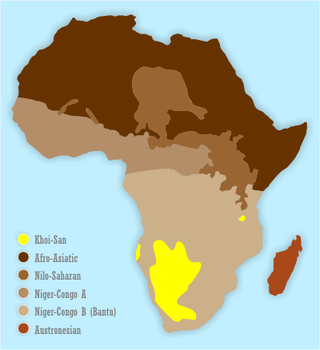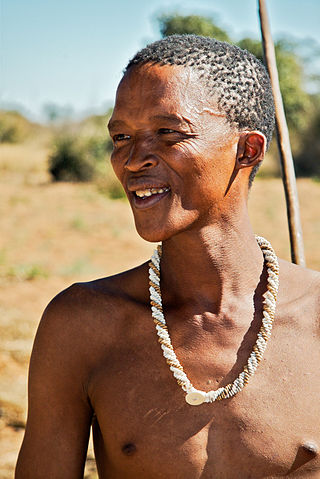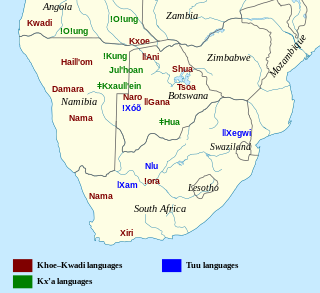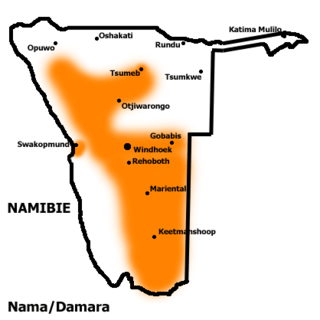
The Khoisan languages are a number of African languages once classified together, originally by Joseph Greenberg. Khoisan is defined as those languages that have click consonants and do not belong to other African language families. For much of the 20th century, they were thought to be genealogically related to each other, but this is no longer accepted. They are now held to comprise three distinct language families and two language isolates.

KhoisanKOY-sahn, or Khoe-Sān, is a catch-all term for the indigenous peoples of Southern Africa who traditionally speak non-Bantu languages, combining the Khoekhoen and the Sān peoples. Khoisan populations traditionally speak click languages and are considered to be the historical communities throughout Southern Africa, remaining predominant until European colonisation in areas climatically unfavorable to Bantu (sorghum-based) agriculture, such as the Cape region, through to Namibia, where Khoekhoe populations of Nama and Damara people are prevalent groups, and Botswana. Considerable mingling with Bantu-speaking groups is evidenced by prevalence of click phonemes in many especially Xhosa Southern African Bantu languages.

The San peoples, or Bushmen, are the members of any of the indigenous hunter-gatherer cultures of southern Africa, and the oldest surviving cultures of the region. Their recent ancestral territories span Botswana, Namibia, Angola, Zambia, Zimbabwe, Lesotho, and South Africa.

TaaTAH, also known as ǃXóõKOH, is a Tuu language notable for its large number of phonemes, perhaps the largest in the world. It is also notable for having perhaps the heaviest functional load of click consonants, with one count finding that 82% of basic vocabulary items started with a click. Most speakers live in Botswana, but a few hundred live in Namibia. The people call themselves ǃXoon or ʼNǀohan, depending on the dialect they speak. The Tuu languages are one of the three traditional language families that make up the Khoisan languages. In 2011, there were around 2,500 speakers of Taa.

The KhoekhoeKOY-koy language, also known by the ethnic terms Nama (Namagowab) NAH-mə, Damara (ǂNūkhoegowab), or Nama/Damara and formerly as Hottentot, is the most widespread of the non-Bantu languages of Southern Africa that make heavy use of click consonants and therefore were formerly classified as Khoisan, a grouping now recognized as obsolete. It belongs to the Khoe language family, and is spoken in Namibia, Botswana, and South Africa primarily by three ethnic groups: Namakhoen, ǂNūkhoen, and Haiǁomkhoen.

Juǀʼhoan, also known as Southern or Southeastern ǃKung or ǃXun, is the southern variety of the ǃKung dialect continuum, spoken in northeastern Namibia and the Northwest District of Botswana by San Bushmen who largely identify themselves as Juǀʼhoansi. Several regional dialects are distinguished: Epukiro, Tsumǃkwe, Rundu, Omatako and ǂKxʼauǁʼein, with Tsumǃkwe being the best described and often taken as representative.
Naro, also Nharo, is a Khoe language spoken in Ghanzi District of Botswana and in eastern Namibia. It is one of the most-spoken of the Tshu–Khwe languages. Naro is a trade language among speakers of different Khoe languages in Ghanzi District. There exists a dictionary.
Gǀui or Gǀwi is a Khoe dialect of Botswana with 2,500 speakers. It is part of the Gǁana dialect cluster, and is closely related to Naro. It has a number of loan words from ǂʼAmkoe. Gǀui, ǂʼAmkoe, and Taa form the core of the Kalahari Basin sprachbund, and share a number of characteristic features, including extremely large consonant inventories.

KhweKWAY is a dialect continuum of the Khoe branch of the Kwadi-Khoe family of Namibia, Angola, Botswana, South Africa, and parts of Zambia, with some 8,000 speakers.
Kwadi was a "click language" once spoken in the southwest corner of Angola. It became extinct around 1960. There were only fifty Kwadi in the 1950s, of whom only 4–5 were competent speakers of the language. Three partial speakers were known in 1965, but in 1981 no speakers could be found.

Sandawe is a language spoken by about 60,000 Sandawe people in the Dodoma Region of Tanzania. Sandawe's use of click consonants, a rare feature shared with only two other languages of East Africa – Hadza and Dahalo, had been the basis of its classification as a member of the defunct Khoisan family of Southern Africa since Albert Drexel in the 1920s. Recent investigations however suggest that Sandawe may be related to the Khoe family regardless of the validity of Khoisan as a whole. A discussion of Sandawe's linguistic classification can be found in Sands (1998).

Herero (Otjiherero) is a Bantu language spoken by the Herero and Mbanderu peoples in Namibia and Botswana, as well as by small communities of people in southwestern Angola. There were 250,000 speakers in these countries between 2015 and 2018.
ǃKungKUUNG (ǃXun), also known as Ju, is a dialect continuum spoken in Namibia, Botswana, and Angola by the ǃKung people, constituting two or three languages. Together with the ǂʼAmkoe language, ǃKung forms the Kxʼa language family. ǃKung constituted one of the branches of the putative Khoisan language family, and was called Northern Khoisan in that scenario, but the unity of Khoisan has never been demonstrated and is now regarded as spurious. Nonetheless, the anthropological term "Khoisan" has been retained as an umbrella term for click languages in general.
Kwanyama or Cuanhama is a national language of Angola and Namibia. It is a standardized dialect of the Ovambo language, and is mutually intelligible with Oshindonga, the other Ovambo dialect with a standard written form.

Ghanzi is a town in the middle of the Kalahari Desert the western part of the Republic of Botswana in southern Africa. The region is the country's pride in contributing a large portion towards the beef industry. In fact, Ghanzi farmers provide about 75% percent of beef exports, according to the Botswana Meat Commission, primarily to the United Kingdom and the European Union.
The KhoeKWAY languages are the largest of the non-Bantu language families indigenous to Southern Africa. They were once considered to be a branch of a Khoisan language family, and were known as Central Khoisan in that scenario. Though Khoisan is now rejected as a family, the name is retained as a term of convenience.

Jehovah is a Latinization of the Hebrew יְהֹוָהYəhōwā, one vocalization of the Tetragrammaton יהוה (YHWH), the proper name of the God of Israel in the Hebrew Bible/Old Testament. The Tetragrammaton יהוה is considered one of the seven names of God in Judaism and a form of God's name in Christianity.
New Xade is a village located in the central part of the Ghanzi District of Botswana. The population was 1,690 in 2021 census.
Mota is an Oceanic language spoken by about 750 people on Mota island, in the Banks Islands of Vanuatu. It is the most conservative Torres–Banks language, and the only one to keep its inherited five-vowel system intact while also preserving most final vowels.










